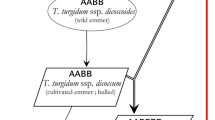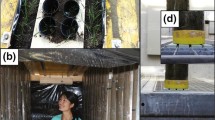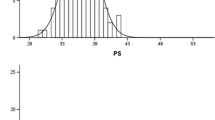Abstract
Drought stress imposes major limits on wheat (Triticum aestivum L.) yield and is predicted to increase in frequency due to climate change. The aim of this study was to explore the potential of synthetic hexaploid wheat (SHW) to improve productivity of winter wheat under drought stress. Six SHW lines and four winter wheat cultivars from the U.S. Great Plains were evaluated in 1 m × 10 cm plastic tubes under drought-stressed and well-watered conditions in a greenhouse study. Root morphology, biomass, stomatal attributes, plant water relations, and the response of these traits to drought stress were measured. Traits significantly (P < 0.05) correlated with a drought tolerance index included root biomass in the bottom third of the tubes, length of the longest root, stomatal conductance, and production of small diameter roots. Plasticity for root biomass allocation to greater depths showed a strong association with maintenance of plant water status. Synthetic line SYN-201 ranked highest for deep root biomass and length of the longest root under stress, and demonstrated plasticity by shifting root biomass production from the upper third to the bottom third of the tubes when stressed. Digital analysis of root morphology indicated that SYN-201, SYN-290, and cultivar Byrd produced large amounts of small diameter roots at depth. SYN-396 showed high stomatal density and reduced stomatal aperture while maintaining leaf growth when stressed despite a lack of deep roots. Trait variation in the SHW lines may contribute beneficial drought tolerance to Great Plains-adapted cultivars through introgression of novel allelic diversity.


Similar content being viewed by others
References
Baenziger PS, Beecher B, Graybosch RA, Baltensperger DD, Nelson L, Krall JM, Mcvey DV, Watkins JE, Hatchett JH, Chen M (2004) Registration of Goodstreak wheat. Crop Sci 44:1473–1474
Barrs HD, Weatherley PE (1962) A re-examination of relative turgidity technique for estimating water deficits in leaves. Austr JBiol Sci 15:413–428
Blum A (2009) Effective use of water (EUW) and not water-use efficiency (WUE) is the target of crop yield improvement under drought stress. Field Crops Res 112:119–123
Blum A (2011) Plant breeding for water-limited environments. Springer Science + Business Media, LLC, New York
Cavanagh CR, Chao S, Wang S, Huang BE, Stephen S, Kiani S, Forrest K, Saintenac C, Brown-Guedira GL, Akhunova A, See D, Bai G, Pumphrey M, Tomar L, Wong D, Kong S, Reynolds M, da Silva ML, Bockelman H, Talbert L, Anderson JA, Dreisigacker S, Baenziger S, Carter A, Korzun V, Morrell PL, Dubcovsky J, Morell MK, Sorrells ME, Hayden MJ, Akhunov E (2013) Genome-wide comparative diversity uncovers multiple targets of selection for improvement in hexaploid wheat landraces and cultivars. Proc Natl Acad Sci USA 110:8057–8062
Chenu K, Cooper M, Hammer GL, Mathews KL, Dreccer MF, Chapman SC (2011) Environment characterization as an aid to wheat improvement: interpreting genotype-environment interactions by modelling water-deficit patterns in North-Eastern Australia. J Exp Bot 62:1743–1755
Dai A (2013) Increasing drought under global warming inobservations and models. Nature Climate Change 3:52–58
Dreisigacker S, Kishii M, Lage J, Warburton M (2008) Use of synthetic hexaploid wheat to increase diversity for CIMMYT bread wheat improvement. Austr JAgric Res 59:413–420
Ehdaie B, Layne AP, Waines JG (2012) Root system plasticity to drought influences grain yield in bread wheat. Euphytica 186:219–232
Ekanayake IJ, O’Toole JC, Garrity DP, Masajo TM (1985) Inheritance of root characters and their relations to drought resistance in rice. Crop Sci 25:927–933
Franks PJ, Drake PL, Beerling DJ (2009) Plasticity in maximum stomatal conductance constrained by negative correlation between stomatal size and density: an analysis using Eucalyptus globulus. Plant Cell Environ 32:1737–1748
Gill KS, Lubbers EL, Gill BS, Raupp WJ, Cox TS (1991) A genetic linkage map of Triticum tauschii (DD) and its relationship to the D genome of bread wheat (AABBDD). Genome 34:362–374
Gregory PJ, Bengough AG, Grinev D, Schmidt S, Thomas WTB, Wojciechowski T, Young IM (2009) Root phenomics of crops: opportunities and challenges. Funct Plant Biol 36:922–929
Haley SD, Quick JS, Johnson JJ, Peairs FB, Stromberger JA, Clayshulte SR, Clifford BL, Rudolf JB, Seabourn BW, Chung OK, Jin Y, Kolmer JA (2005) Registration of ‘Hatcher’ wheat. Crop Sci 45:2654–2655
Haley SD, Johnson JJ, Peairs FB, Quick JS, Stromberger JA, Clayshulte SR, Butler JD, Rudolph JB, Seabourn BW, Bai G, Jin Y, Kolmer J (2007) Registration of ‘Ripper’ Wheat. J Plant Reg 1:1–6
Haley SD, Johnson JJ, Peairs FB, Stromberger JA, Hudson EE, Seifert SA, Kottke RA, Valdez VA, Rudolph JB, Bai G, Chen X, Bowden RL, Jin Y, Kolmer JA, Chen M-S, Seabourn BW (2012) Registration of ‘Byrd’ Wheat. JPlant Reg 6:302–305
Hetherington AM, Woodward FI (2003) The role of stomata in sensing and driving environmental change. Nature 424:901
Hopkins WG, Hüner NPA (2008) Introduction to plant physiology. John Wiley & Sons, Hoboken
Lopes MS, Reynolds MP (2010) Partitioning of assimilates to deeper roots is associated with cooler canopies and increased yield under drought in wheat. Funct Plant Biol 37:147–156
Lopes MS, Reynolds MP (2011) Drought adaptive traits and wide adaptation in elite lines derived from resynthesized hexaploid wheat. Crop Sci 51:1617–1626
Manschadi AM, Christopher J, Devoil P, Hammer GL (2006) The role of root architectural traits in adaptation of wheat to water-limited environments. Funct Plant Biol 33:823–837
McFadden ES, Sears ER (1944) The artificial synthesis of Triticum spelta. Rec Genet Soc Amer 13:26–27
Mujeeb-Kazi A, Hettel GP (eds) (1995) Utilizing wild grass biodiversity in wheat improvement: 15 years of wide cross research at CIMMYT. CIMMYT Research Report No. 2, Mexico
Narayanan S, PrasadPV Vara (2014) Characterization of a spring wheat association mapping panel for root traits. Agron J106:1593–1604
Narayanan S, Mohan A, Gill KS, Vara Prasad PV (2014) Variability of root traits in spring wheat germplasm. PLoS ONE 9:e100317
Palta JA, Chen X, Milroy SP, Rebetzke GJ, Dreccer MF, Watt M (2011) Large root systems: are they useful in adapting wheat to dry environments? Funct Plant Biol 38:347–354
Praba ML, Cairns JE, Babu RC, Lafitte HR (2009) Identification of physiological traits underlying cultivar differences in drought tolerance in rice and wheat. J Agron Crop Sci 195:30–46
Reynolds M, Dreccer F, Trethowan R (2007) Drought-adaptive traits derived from wheat wild relatives and landraces. J Exp Bot 58:177–186
Sayar R, Khemira H, Kharrat M (2007) Inheritance of deeper root length and grain yield in half-diallel durum wheat (Triticum durum) crosses. Ann Appl Biol 151:213–220
Trethowan RM, Mujeeb-Kazi A (2008) Novel germplasm resources for improving environmental stress tolerance of hexaploid wheat. Crop Sci 48:1255–1265
van Ginkel M, Ogbonnaya F (2007) Novel genetic diversity from synthetic wheats in breeding cultivars for changing production conditions. Field Crops Res 104:86–94
WHEAT (2014) Wheat: vital grain of civilization and food security 2013 Annual Report, CGIAR Research Program on Wheat, Mexico
Ytting NK, Andersen SB, Thorup-Kristensen K (2014) Using tube rhizotrons to measure variation in depth penetration rate among modern North-European winter wheat (Triticum aestivum L.) cultivars. Euphytica 199:233–245
Zadoks JC, Chang TT, Konzak CF (1974) A decimal code for the growth stages of cereals. Weed Res 14:415–421
Acknowledgments
Funding for this research was provided by U.S. Department of Agriculture-National Institute of Food and Agriculture grants 2008-55100-04509 and 2011-68002-30029. We appreciate technical assistance provided by Ms. Jessica McGowan and Ms. Jennifer Matsuura and valuable comments on this manuscript by Dr. Greg McMaster.
Author information
Authors and Affiliations
Corresponding author
Electronic supplementary material
Below is the link to the electronic supplementary material.
Rights and permissions
About this article
Cite this article
Becker, S.R., Byrne, P.F., Reid, S.D. et al. Root traits contributing to drought tolerance of synthetic hexaploid wheat in a greenhouse study. Euphytica 207, 213–224 (2016). https://doi.org/10.1007/s10681-015-1574-1
Received:
Accepted:
Published:
Issue Date:
DOI: https://doi.org/10.1007/s10681-015-1574-1




